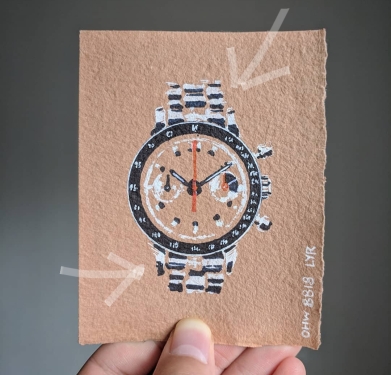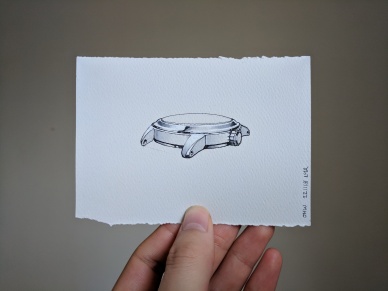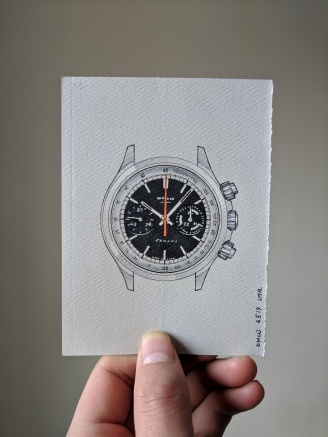Watch Terminology for Dummies, Part 2: Defining More Watch Terms for Those Who are Clueless
As mentioned in the previous blog post (and if you haven’t read it, this one isn’t going to make a whole lot of sense to you, so go read it), I felt it was my duty to create a glossary of watch terms using definitions that were simplified enough for someone like Boris Johnson (aka, a dumbf*ck) to understand. Today’s post is a continuation of that concept. Hope you enjoy this one as much as you seemingly liked the first (or at least, will click on this link as much as you did the other so that my overblown ego stays solidly intact).

Bracelet
While the word was originally defined in the 1990s as, “what guys who own Emporio Armani watches wear multiples of in yellow gold on the opposite wrist”, the term now applies to a part of an actual timepiece.
A bracelet is usually made of metal or ceramic, it is often adjustable, and it can be worn in place of most watch straps.
Bridge
Not just a weekly card game played by groups of bitter women who sometimes throw tantrums when they feel they’re not winning (and no, this time I’m actually not referring to some of the people I’ve come across in my journalistic career), a bridge is also an essential part of a mechanical watch. A watch’s bridge is a bar or plate attached to the main plate with pins or screws and often labeled for the function or part in which the bridge supports.
Calendar
FFS, if you don’t know what this is on a watch, don’t waste your money. You have an iPhone. Stick with that, genius.
Caliber
No, pistol lovers, this isn’t the “Gun Terminology for Dummies” post. You’ll find that in any transcript of any Wayne LaPierre speech ever made. But you may want to check the NRA fan page. I hear it’s “buy one President, get one rifle free.” day.
Caliber, as it pertains to watches, refers to the watch’s movement. An in-house movement should (SHOULD!) refer to a movement made entirely (ENTIRELY!) by the watch manufacturer and not by outside sources.

Calibre
This is America, so this word doesn’t matter.
Case
Think of this part of a watch as its shell if that shell was waterproof, dust proof, moisture proof, and sometimes, inexperienced-watchmaker proof.
The case of a watch can be simple or ornate; embellished with gems or contain varying degrees of elaborate engraving. It is a large part of what gives any timepiece its beauty while still being as functional as many of the watch’s alternate parts.
Case Back
(Sigh.) The back part of the definition above.
Chronograph
I’m super excited about this entry because I’m pretty sure this was the first legitimate watch term I ever learned. And while that was only like two weeks ago, still, it holds a special place in that thing in my chest that consistently makes thumpy type noises and causes me pain on a daily basis.

The word, “chronograph” comes from the Greek language and means, simply, “recording time.” Traditional chronograph watches doubled as stopwatches, though some modern chronographs use moveable bezels as tachymeters for calculations of distance as well as speed.
Chronometer
So, apparently the Swiss are the only people who can say whether or not a watch can be considered a certified “chronometer”. Yes, you heard that right, the same country that refused to take a stance in World War I or World War II by, oh, I don’t know, picking a side, has decided that NOW they’ll stand firm in their beliefs when it comes to the label your precious wrist clock should have. But hey, who am I to judge? After all, my father is Italian and my mother is German. (Does this not explain so much about my anger issues?)
All kidding aside (no, seriously Swissies, I don’t care whom exactly I piss off with these cheeky posts, but I certainly wouldn’t want it to be you, because being tortured with a giant cheese grater by an overtly indifferent executor is not the way I picture myself leaving this world), a Swiss wristwatch can be considered a chronometer if the Contrôle Officiel Suisse des Chronomètres (or, “COCS” for sho… no… wait… wait, I’m wrong… I’m sorry, I meant “COSC” for short, my bad) deems it so by testing and certifying that these types of mechanical timepieces meet certain precision standards.
Cloisonné
As a former metalsmith’s apprentice and junior bench jeweler, this is one definition I’m going to take seriously. The ancient art of cloisonné is still in use in the watch world today, usually seen on a watch’s dial. The decorative technique starts with the use of metal as both a backdrop and in the outline of the design itself (which will also come through in the finished product) before an enamel paste is added then fired in a kiln. Other materials which can be inlayed during the cloisonné process are minerals, gemstones, and glass.
Stay tuned for more definitions in upcoming blog posts. And if you like the artwork seen here, it was once again provided by the extraordinary Lee Yuen-Rapati – aka – OneHourWatch. Find him on Instagram, @onehourwatch, or for inquiries, email him at leeyuenrapati@gmail.com.

July 31, 2019 at 12:59 PM
> Calibre
>
> This is America, so this word doesn’t matter
Ha! Thanks for the laugh while eating my breakfast.
LikeLike
August 4, 2019 at 12:01 PM
[…] I enjoy especially What’s On Her Wrist due to watch-related articles. By the way, the last Watch Terminology for Dummies is a must-read for anyone, regardless if novice or […]
LikeLike